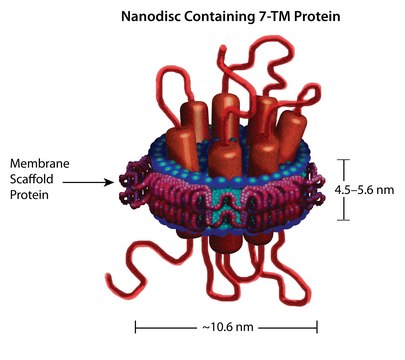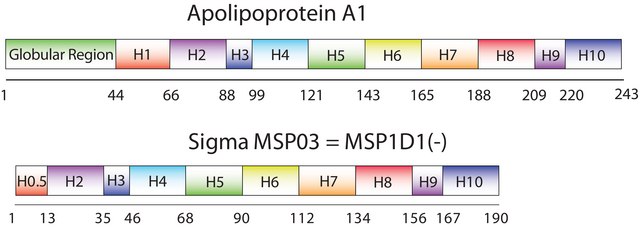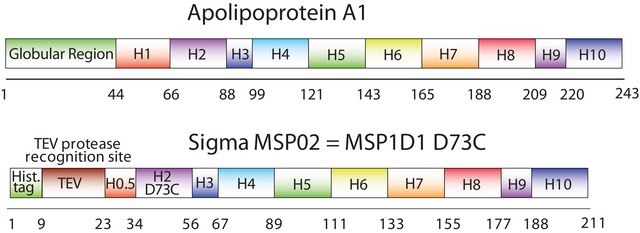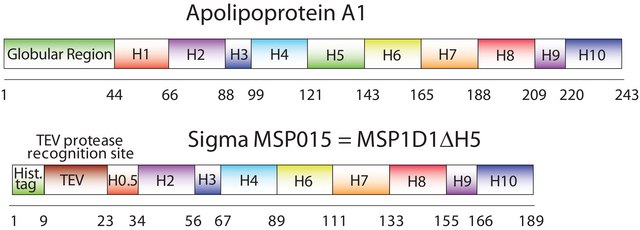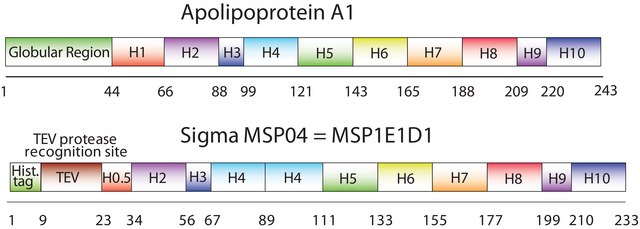MSP01
Membrane Scaffold Protein 1D1
recombinant, expressed in E. coli, buffered aqueous solution
Synonym(s):
Membrane Scaffold Protein 1D1, MSP1D1, MSP1T2
Sign Into View Organizational & Contract Pricing
All Photos(4)
About This Item
UNSPSC Code:
12352200
NACRES:
NA.26
Recommended Products
recombinant
expressed in E. coli
Quality Level
Assay
≥90% (SDS-GE)
form
buffered aqueous solution
mol wt
24,661.6 Da
solubility
water: soluble
shipped in
dry ice
storage temp.
−20°C
Looking for similar products? Visit Product Comparison Guide
General description
Research area: Cell signaling. Nanodiscs are non-covalent structures that contain a phospholipidbilayer and a membrane scaffold protein (MSP), a genetically engineeredprotein, that mimics the function of Apolipoprotein A-1 (ApoA-1). The firstMSP, MSP1, was engineered with its sequence based on the sequence of A-1, butwithout the globular N-terminal domain of native A-1. The Membrane ScaffoldProtein 1D1 (MSP1D1) variant of MSP1 deletes the first 11 amino acids in theHelix 1 portion (referred to as “H0.5” in the accompanying figure) of theoriginal MSP1 sequence.It consists of an N-terminal histidine-tagged protein with a tobaccoetch virus (TEV) protease cleavage site that is present between the proteinsequence and histidine-tag.Nano-disctechnology is an approach that allows aqueous soluble membrane proteins in anative-like bilayer environment that enables the membrane proteins to remainactive and stable.
Application
For an extensive list of citations and protocols visit the Sligar Lab Website at; sligarlab.life.uiuc.edu/nanodisc.html
For guidelines on the use of this and other MSP′s to prepare Nanodiscs, please visit our Protocols for Membrane Scaffold Proteins and Nanodisc Formation page.
Nanodisc soluble lipid bilayer systems have proven to be a widely applicable means for rendering membrane proteins soluble in aqueous solutions in a native-like bilayer environment where they remain monodisperse and active. The critical component of nanodiscs is the encircling amphipathic helical protein belt (membrane scaffold protein).
The nanodisc system has been employed to incorporate a wide variety of proteins including GPCRs, P450s, bacteriorhodopsin, coagulation factors, cholera toxin, TAR receptor and aromatase.
Biochem/physiol Actions
Generates Nanodiscs ~9.7 nm in diameter
MSP1D1 can self-assembleinto discoidal nanoparticles known as nano-discs. These nano-discs may be used inthe field of medicine, biotechnology, and membrane protein studies.
Legal Information
Nanodisc technology, and many of its uses, are covered by the following patents held by the University of Illinois.
- 7,691,414 Membrane scaffold proteins
- 7,662,410 Membrane scaffold proteins and embedded membrane proteins
- 7,622,437 Tissue factor compositions and methods
- 7,592,008 Membrane scaffold proteins
- 7,575,763 Membrane scaffold proteins and tethered membrane proteins
- 7,083,958 Membrane scaffold proteins
- 7,048,949 Membrane scaffold proteins
Nanodisc technology, and many of its uses, are covered by the following patents held by the University of Illinois.
- 7,691,414 Membrane scaffold proteins
- 7,662,410 Membrane scaffold proteins and embedded membrane proteins
- 7,622,437 Tissue factor compositions and methods
- 7,592,008 Membrane scaffold proteins
- 7,575,763 Membrane scaffold proteins and tethered membrane proteins
- 7,083,958 Membrane scaffold proteins
- 7,048,949 Membrane scaffold proteins
Storage Class Code
10 - Combustible liquids
WGK
WGK 2
Flash Point(F)
Not applicable
Flash Point(C)
Not applicable
Choose from one of the most recent versions:
Already Own This Product?
Find documentation for the products that you have recently purchased in the Document Library.
Customers Also Viewed
Our team of scientists has experience in all areas of research including Life Science, Material Science, Chemical Synthesis, Chromatography, Analytical and many others.
Contact Technical Service
